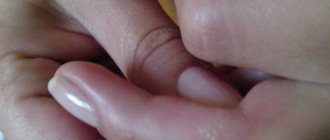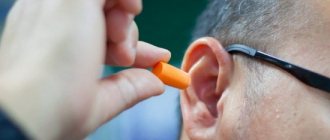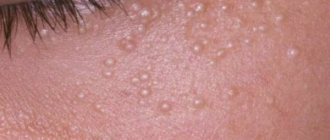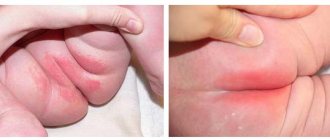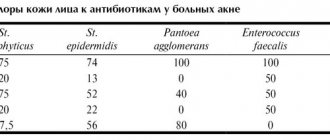Watery blisters on the skin of the hands: What is it?
Watery blisters on the hands are small formations protruding above the skin level, the diameter of which does not exceed half a centimeter. They differ from healthy skin in color and in most cases are red or pinkish in color. Inside, such rashes are filled with clear (serous) or bloody fluid.
When rubbed or pressed, the bubbles can burst, leaving a wound in their place. This most often occurs with blisters on the palms of the hands when a person wipes their hands, grasps a door handle, or performs other daily activities.
Typically, the appearance of watery blisters on the fingers or toes is preceded by redness of the skin, possibly peeling and increased sensitivity. Also, the rash is sometimes accompanied by swelling, burning and itching.
Before you begin treatment for the disease, you need to accurately determine the cause of the rash. As a rule, when the cause is eliminated, the rash goes away quite quickly: usually within a few days, sometimes longer. Let us list the main reasons that cause such a reaction.
Allergy
Watery blisters between the fingers, palms and hands can be a manifestation of an allergy to cosmetics, the sun or chemicals. In this case, itchy pimples appear exactly in the place that came into contact with the allergen. Most often these are fingers or palms, but sometimes also wrists (the reaction can occur, for example, to a watch strap).
The blisters may be painful, itchy, and crusty. This is quite dangerous: damage to the crust can lead to purulent infection. Without treatment, the rash can grow, coalesce, and affect more and more of the skin.
Infectious diseases
Watery blisters on the hands can be a symptom of an infectious disease. If the red rashes are very itchy and spread from the palms of the hands to the stomach and legs, there is a possibility that the patient has scabies. Such blisters can appear after a scabies mite bite or as a result of contact with a sick person in a public place. Scabies is a very painful and contagious disease, so it needs to be treated urgently.
Often, a rash on the hands can be a consequence of other infectious diseases: chickenpox, rubella, measles, enterovirus infection, etc. These diseases are thought to affect children more often, but in fact, teenagers and adults can also become infected. Depending on the type of disease, the rash may vary in shape and size. These can be small subcutaneous pimples or larger ones with pus.
If, in addition to rashes, a person feels unwell, has a fever and a headache, the likelihood of an infectious disease increases. Call a doctor immediately!
Internal diseases
Disorders of the gastrointestinal tract (gastritis, ulcers and other diseases) also affect the condition of the skin. Exacerbation of such diseases can lead to skin rashes in the form of small, fluid-filled blisters. This indicates the accumulation of toxins in the body or metabolic disorders.
Treatment of blisters on the hands in these cases should be comprehensive. First of all, you need to cleanse the body of toxins and restore the functioning of the gastrointestinal tract. Local treatment for this reason will not work.
Skin diseases
Rashes with clear liquid may also indicate fungal diseases. Along with the rash, the skin may become dry, red, and flaky. Another symptom of fungus is severe itching. At the slightest suspicion of a fungus, you should immediately contact a dermatologist, as the disease can infect your loved ones.
External reasons
Blisters on the skin may be a reaction to thermal burns from hot water, steam, iron or other devices. Burned skin usually feels hot and sore and red. After some time, a bubble forms at the burn site.
Types of red moles
The appearance of red moles on the body can be accompanied by various visual characteristics of the defect. Such epidermal formations can be either flat, forming in the deep dermal layers, or have a superficial nature, protruding above the skin. Moreover, according to the nature of the visual picture, all angiomas are usually divided into two groups:
- Spot. The pigmented area has clear red borders and is a point at which a collection of vessels and capillaries is concentrated. Often, punctate angiomas are multiple in nature, manifesting themselves in the form of specific “rashes” on the patient’s skin.
- Star-shaped. Such moles are a collection of tiny thin vessels that are visible through the epidermis and converge at a central point, forming a kind of star. These structures are also associated with diseases such as rosacea.
In addition, a separate group includes especially large red moles on the body - hemangiomas, which usually significantly spoil the patient’s appearance and require cosmetic correction.
Treatment
If you have itchy, watery blisters on your hands, seek help. The more severe the rash, the more often they are accompanied by a deterioration in general condition and an increase in temperature. If the blisters grow, turn red and hurt (possibly even fester), and the area around them swells, it is better to call an ambulance, as there is a high probability of infection.
In any case, only a doctor will determine the exact cause of the disease and tell you how to treat the blisters on your fingers. Don't panic: in the vast majority of cases, rashes go away as soon as the cause of their occurrence is eliminated. This may happen in a few days or weeks.
Treatment of the disease is chosen after diagnosis. If the cause of the itchy rash is scabies, it will be treated with external medications within a week. The therapy uses sulfur ointment for watery blisters on the hands and other medications.
If the rash in children or adults is caused by chickenpox, the patient may be hospitalized. For mild forms, treatment is possible at home. Patients are recommended antiviral and antipyretic drugs and local remedies that dry out pimples.
Fungal blisters are treated with topical creams and ointments. They are used to treat the affected areas. Often such drugs are toxic, so only a doctor should select them.
If watery blisters on the hands become an allergic reaction, treatment will be carried out using antihistamines: internal and external.
In any case, you should not diagnose yourself. This can only harm you. Let your doctor determine the cause of the problem and tell you what to do.
Why are red moles dangerous?
If a red mole does not bother its owner and does not change its external characteristics, it can be argued that such a formation does not pose a significant threat to the health and life of the patient. At the same time, you should get professional medical advice and resort to modern therapeutic methods if you have the following manifestations:
- The red mole grows or changes its shape;
- The patient experiences pain, itching or burning in the area where the pigmented formation is located;
- The mole is bleeding;
- Superficial structures or ulcerations appear;
- There are more than 6 small red dots in one area of the body.
All these symptoms may indicate the development of an oncological process. In addition, the category of dangerous moles includes angiomas located in places where they can be easily injured when wearing clothes, shoes, jewelry, etc. Mechanical damage to such a formation can provoke the appearance of new red moles on the body, activate malignant transformation and leave scars or scars on the skin.
Cream La-Cri for sensitive skin of hands
Whatever the cause of the lesion, the skin suffers in any case. Patients experience increased sensitivity to cosmetics and chemical components, so they are advised to abandon conventional cosmetics and give preference to neutral hygiene products.
Special La-Cri products will help fight inflammation and provide gentle skin care. Instead of regular soap, it is better to switch to a soft cleansing gel that is suitable for the entire body and face. After washing, the skin can be lubricated with anti-inflammatory and softening cream.
The La-Cri skin care series is developed on the basis of natural ingredients (healing oils, panthenol, plant extracts). These products do not contain hormones, dyes, fragrances or parabens, so they can be regularly used by children from the first days of life and by adults with sensitive skin. Such cosmetics will help speed up treatment and restore skin faster.
To prevent relapse, lead a gentle lifestyle. Try to get rid of bad habits, maintain hygiene, avoid contact with chemicals (wear gloves).
Should I see a doctor?
It is recommended to visit a doctor in any case, even if there is a red spot that does not itch or hurt. The dermatologist will conduct an examination and questioning, prescribe additional examination if necessary and tell you how to get rid of red dots on the body. Most often, you need to take a general blood test and a scraping from the affected area; a little less often, tissue is taken for a biopsy. Diagnosis of the disease is difficult; self-medication is extremely undesirable, so as not to harm your health.
Clinical researches
The conducted clinical study proves the high efficiency, safety and tolerability of products for daily skin care of children with mild and moderate forms of atopic dermatitis and during remission, accompanied by a decrease in the quality of life of patients. As a result of therapy, a decrease in the activity of the inflammatory process, a decrease in dryness, itching and flaking was noted.
The composition of La Cree cream for sensitive skin includes:
- Violet extract and bisabolol (the active ingredient of chamomile) have an anti-inflammatory and soothing effect;
- Extracts of string and licorice have anti-inflammatory properties, have an antipruritic effect, relieve redness and flaking of the skin;
- Walnut extract has antimicrobial, anti-inflammatory and healing effects.
- Panthenol and avocado oil have a regenerating and softening effect, nourish and moisturize the skin.
The conducted clinical study proves the high efficiency, safety and tolerability of products for daily care of children's skin, including skin with mild and moderate forms of atopic dermatitis and during remission, accompanied by a decrease in the quality of life of patients. As a result of therapy, a decrease in the activity of the inflammatory process, a decrease in dryness, itching and flaking was noted.
Sources:
- Sukolin Gennady Ivanovich, Illustrated clinical dermatology. Brief alphabetical reference book, publishing house Lux Print, 2010
- Chapman M. Shane, Habiff Thomas P., Zug Catherine A., Dinoulos James G. H., Campbell James L., Dermatology. Handbook of differential diagnosis, publishing house: MEDpress-inform, 2014
- Molochkova Yulia Vladimirovna, Dermatology. Brief reference book, publishing house: GEOTAR-Media, 2017
Associated symptoms
Some red spots on the hands do not itch and are not accompanied by additional symptoms, that is, they do not bother a person in any way. For this reason, the patient consults a doctor when the pathology has already become chronic. Among such ailments are skin hemangioma, vitamin deficiency, impaired functionality of blood vessels, and syphilis. The latter disease does not cause inflammation of the epidermis for a long time, but there are ulcers and fever.
Infections can almost always be recognized by characteristic symptoms, which are divided into local and general. The first group easily includes rashes of various types, itching and burning, peeling, the appearance of crusts on the surface or weeping wounds. The second group includes fever, the appearance of weakness and apathy, sore throat and head, loss of appetite or sleep disturbance. In addition, it is possible to enlarge the lymph nodes, which are located closer to the red spots on the body.
Preventive measures
After successful therapy, simple rules should be followed. They will help maintain remission for a long time, as well as prevent other pathologies. Recommendations to remember if you have sores on your body:
- sunbathe only in the morning or evening, when ultraviolet rays are not so active;
- do not forget to use sunscreen;
- regularly moisturize the skin (especially in summer and winter) using suitable care products;
- Drink enough fluids per day to avoid dehydration;
- arrange fasting days, cleansing the intestines and liver of toxins;
- visit doctors in a timely manner, identifying health problems;
- monitor moles, angiomas and hemangiomas of the skin, paying attention to their size and color.
Red dots can signal an allergy or a serious problem in the body, and can also be a reaction to stress. If painful spots on the body spread and itch, it is better to immediately consult a specialist. Often, pimples are not something serious and disappear on their own.
You can ask your question to our author:


